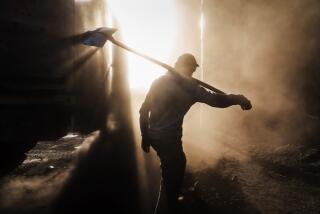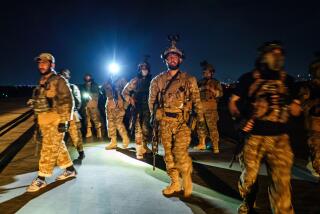Bin Laden Trail Grows Fainter, Pentagon Says
- Share via
WASHINGTON — Intelligence reports on the whereabouts of Osama bin Laden are drying up, the Pentagon said Monday, as Afghan militia fighters went cave to cave in search of the terrorist leader and what remains of his largely defeated Al Qaeda fighters in Tora Bora.
Though the lack of current evidence placing Bin Laden in the Tora Bora region of eastern Afghanistan doesn’t necessarily mean he has escaped, a top U.S. military official said, Bin Laden’s whereabouts are “anybody’s guess.”
Bombing in the region abated to enable anti-Taliban forces, backed by U.S. troops, to search the cave networks and chase fleeing Al Qaeda fighters. Pockets of resistance remained, and Pentagon officials warned that that will continue.
Meanwhile, hopes were rising that another missing target of U.S. and anti-Taliban forces might have been located near Kandahar in southern Afghanistan. Pushtun forces reportedly are preparing to attack a mountain redoubt where former Taliban leader Mullah Mohammed Omar is believed to be hiding.
After saying for days that it had no idea where Omar might have gone after the Taliban lost its grip on Kandahar on Dec. 7, the new government there said Monday that it believes that he has taken refuge about 100 miles to the northwest, with 400 to 500 supporters.
Haji Gulalai, the intelligence chief appointed by Kandahar Gov. Gul Agha Shirzai, told reporters that Shirzai intends to send his forces to find Omar and his followers, but he gave no specifics.
“We confirm this news,” Gulalai said. “This is based on information we are getting from our spy network.”
Gulalai said Omar is believed to be in Baghran, in the extreme north of Helmand province, home to a number of caves in which the former Taliban leader might hide.
Helmand is a desolate and sparsely populated province just west of Kandahar. Many Taliban sympathizers are thought to remain there, despite the collapse of the movement throughout the country in the last month.
As resistance to the U.S.-led campaign in Afghanistan faded, Britain said Monday that peacekeeping troops could be in the country by this weekend. Prime Minister Tony Blair said Britain will contribute as many as 1,500 troops to the multinational force, which he expects to be on the ground for “several months” under British leadership.
At the Pentagon, Rear Adm. John D. Stufflebeem described a slow and methodical search of cave and tunnel complexes in eastern Afghanistan, where Al Qaeda fighters may still be hiding after a two-week siege. Though hundreds reportedly have been killed and some have fled, others might remain, possibly including Bin Laden, he told reporters at a briefing.
At the same time, Stufflebeem said, Afghan and U.S. troops were tracking Al Qaeda forces who are trying to escape south to Pakistan, a difficult and painstaking process he compared to “searching for fleas on a dog.”
Stufflebeem, a senior operations officer of the Joint Chiefs of Staff, acknowledged that after believing that they were close to grabbing Bin Laden, U.S. military leaders are now unsure where he is.
Though “a few days ago, we believed he was in that area” based on reports from prisoners and intercepts of radio transmissions, Stufflebeem said, his location now is “anybody’s guess” because information is harder to come by.
“The sense we have is that there’s been less chatter in the last few days. And that would make sense, because there have been fewer fighters in those caves,” he said.
Tora Bora Remains ‘Our Top Priority’
Despite the tapering off of U.S. airstrikes, he said, the Tora Bora area remains “our top priority.”
Afghan opposition forces have captured increasing numbers of Taliban and Al Qaeda fighters, he said, but he added that so far only five have been turned over to U.S. forces. Those prisoners, who include American John Walker Lindh, have been sent to the amphibious assault ship Peleliu in the Arabian Sea, either for health reasons, for better security or to make it easier to interrogate them.
Stufflebeem said he could not identify the other four men, although he said they are non-Afghans. A Marine spokesman in southern Afghanistan said one is an Australian captured while fighting on the Taliban side.
Although Stufflebeem said he did not believe that large numbers of Al Qaeda fighters are crossing the border, he said Pakistani troops had captured some, estimating their numbers at fewer than 100. On Sunday, U.S. special operations soldiers and Afghan rebel warriors captured 30 or 31 Al Qaeda prisoners in the region and a large cache of Chinese ammunition, Defense Secretary Donald H. Rumsfeld said.
The concerns over Al Qaeda fighters escaping into Pakistan are growing daily. Rumsfeld, speaking in Brussels, issued a warning to Afghan opposition leaders who might have negotiated deals that allowed Al Qaeda members to go free.
“To the extent that we find that people who aspire to high office or high position in Afghanistan have been involved in preventing us from getting our hands on people who are responsible for what’s going on in Afghanistan, they will find the United States not terribly friendly to their aspirations,” he said.
Still, escape carries its risks. By one estimate, about 500 Al Qaeda troops fled Tora Bora toward Pakistan through mountain passes. The remnants of Bin Laden’s army, traveling with little food, water and ammunition, may find the snow and biting-cold mountain nights as fearful an enemy as U.S. warplanes.
But the greatest concern remained Bin Laden. U.S. intelligence officials say they cannot confirm persistent reports that he has escaped to Pakistan, and they say he might yet turn up among the many Al Qaeda fighters whose bodies are being found in the bombed-out caves.
“We remain conflicted,” a U.S. intelligence official said.
Speaking with reporters at the White House after a ceremony marking Eid al-Fitr, the end of the Muslim holy month of Ramadan, President Bush said Pakistan is helping the United States in the search for Bin Laden and other Al Qaeda leaders.
“We get all kinds of reports that he’s in a cave, that he’s not in a cave, that he’s escaped or that he hasn’t escaped. There’s all kinds of speculation. But when the dust clears, we’ll find out where he is and he’ll be brought to justice,” the president said.
In London, Blair told the House of Commons that peacekeeping troops could come from Canada, Australia, Argentina, Jordan and New Zealand, among other countries.
“The actual time limit is not specifically decided yet, although at the moment people are talking in terms of several months,” Blair said. “So that would mean the British force is not there on a long-term basis. It is to get the security force going.”
A spokesman for the prime minister called the deployment “a starter pack” for a peacekeeping force likely to remain in Afghanistan for the predicted two-year “transition to democracy.” “The idea is that this will gradually evolve into an Afghan force with a rolling force of peacekeepers with various countries contributing along the way,” he said.
Blair said the United States had agreed to provide “full logistical support” and air cover for the peacekeepers.
Opposition Conservative leader Iain Duncan Smith warned that British peacekeepers could become a target for Taliban fighters still on the loose. Blair responded that the international community cannot turn its back on Afghanistan as it has in the past.
“If the international community walks away from Afghanistan now, it will make exactly the same mistake that was made 10 or 12 years ago when it left Afghanistan to become what it became--a failed state.”
Richter reported from Washington and Daniszewski from Kandahar. Times staff writers Marjorie Miller in London, John Hendren in Brussels, James Gerstenzang in Washington and David Lamb in Tora Bora contributed to this report.
More to Read
Sign up for Essential California
The most important California stories and recommendations in your inbox every morning.
You may occasionally receive promotional content from the Los Angeles Times.














